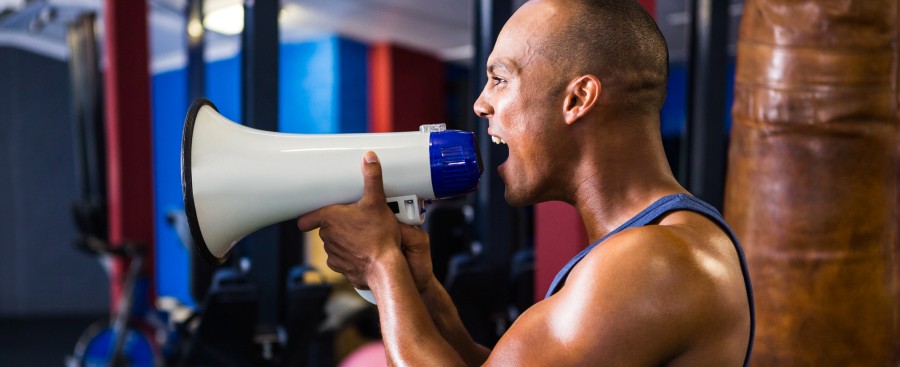 By Noël Nocciolo and Ashley FitzSimmons-Olsen, Special FBA Contributors
By Noël Nocciolo and Ashley FitzSimmons-Olsen, Special FBA Contributors
When considering a long career in the fitness industry, coaches often focus on injury prevention to keep their bodies in top shape. We know that building strength and cross-training can help prevent physical injuries we can see, and whose effects we certainly can feel. We understand the significance of warming up and cooling down to prime our bodies for a solid performance and to aid in recovery.
We guide members to modify an exercise if they’re injured or rehabbing an injury, to help them care for their bodies while still participating in a movement practice. We take many measures to care for our bodies and the bodies of members in training sessions. Vocal injuries that we hear are every bit as detrimental to a flourishing, years-long career as physical injuries we can see; but how often do fitness professionals consider their voice? Not often enough, it seems.
Research shows us that anywhere from 55% to 79% of group fitness instructors surveyed across several studies have self-reported symptoms or diagnoses of vocal problems, as compared to 30% of the general population (Davis, 2020; Fontan et al., 2017; Roy et al., 2005; Rumbach, 2013a). Vocal health is an often overlooked yet critical aspect of career longevity in fitness professionals. We rely on our voices to guide, lead, coach, and inspire, and it’s time we seriously consider the voice to be just as important as any other system in the body.
Have you ever finished teaching class and thought, “wow, my voice feels tired”? Ever felt tightness in your throat after teaching? How about experiencing vocal hoarseness after teaching? These are all signs that you may need to adjust your vocal health routine. The great news is that adjusting your routine is simple to do, as well as necessary for a long-lasting career.
One of the biggest pitfalls to healthy, sustainable voice use for fitness professionals wanting to fill their schedules with a loyal following now and for many years to come, is shouting or screaming while leading class. Our voice is produced using a delicate system of muscles and tissue, with the star of the show being the vocal folds, or vocal cords, as they are commonly known. When sound is produced, the vocal folds gently come together as air flows between them. Shouting and screaming cause the vocal folds to slam together repeatedly, which can cause swelling and even vocal injury.
Research shows us that anywhere from 55% to 79% of group fitness instructors surveyed across several studies have self-reported symptoms or diagnoses of vocal problems, as compared to 30% of the general population (Davis, 2020; Fontan et al., 2017; Roy et al., 2005; Rumbach, 2013a).
These types of injuries require treatment, rest, and behavioral modification to heal and move forward with healthy voice use. It’s also not just the vocal folds that suffer when we yell; the surrounding muscles in the laryngeal area become tight, stressed, and strained, which can lead to pain and unhealthy voice production. The good news: we can amplify the voice without shouting or screaming by using a microphone!
Microphones are a hugely important tool for protecting the voice and ensuring members can hear and understand your cues. The sole job of a microphone is to amplify your voice, so there is no need to shout when using one! In fact, shouting into a mic will distort your words and make it more difficult for members to understand what you say. Talk about counterproductive!
Here are a few tips for you and for the facility team to consider:
- Along with new-hire paperwork including tax forms and facility expectations, be sure you know how to operate the mic and music systems before showing up to teach. If this is not part of onboarding, ask for a walk-through of the group fitness room where your classes will be, so you can ask questions about these important systems, if needed. Sound and mic systems can vary from facility to facility, and if you teach at more than one place, do be sure you’re prepared and set up for success!
- Have a simple-to-read 1-pager with the dos and don’ts posted at the music and mic unit for instructors to follow. Can the mic volume only go as far as x amount? Make a note! Can the music volume only be pumped to y level? Write it down! If you’re an operations manager or group fitness manager and you know this hasn’t been updated in awhile, give it a check.
- During class, be sure to wear the headset and mic pack according to your studio’s standard operating procedure to make sure you take good care of this equipment, just like the equipment helps take care of you. Be sure, too, that you know how and where to store it when you’re finished.
- Conduct a mic check before you begin teaching your class. Check your vocal balance with the music and walk around the room to test your levels in each area of the space. Believe it or not, there may be a dead zone, even in a small room, that can impede members’ ability to hear you during class. Move around the space. Once your class fills up with people, know that their bodies will absorb sound, as well! You may want to bump up your levels a bit to adjust for a full class. 10 members in class or 40 members in class will mean different sound levels.
Taking these quick steps before you begin teaching can help to prevent surprises that may interrupt the flow of your class while allowing you to speak at a healthy volume in a healthy way.
For more free resources to preserve, enhance and protect your voice for career longevity in the fitness industry, visit www.pepforfitpros.com and follow PEP For FitPros on Instagram @pepforfitpros.
Noël Nocciolo, seasoned instructor and successful industry consultant, travels the world creating boutique indoor cycling programs & advising studio owners. Noël developed a passion for helping instructors focus on vocal performance after hearing voice damage worldwide, as well as after once hearing her own class video and realized she was mimicking another instructor rather than coaching as her own authentic self. Leveraging her performing background, 15 creative years in NYC and extensive resume, she provides simple education and tangible tools that significantly improve an instructor’s class.
Ashley FitzSimmons-Olsen, M.S., CCC-SLP worked professionally as a performer and taught theater and dance, and is now a licensed, certified speech-language pathologist, having worked in a variety of settings as a speech-language pathologist treating communication disorders across the lifespan.


Join the Conversation!